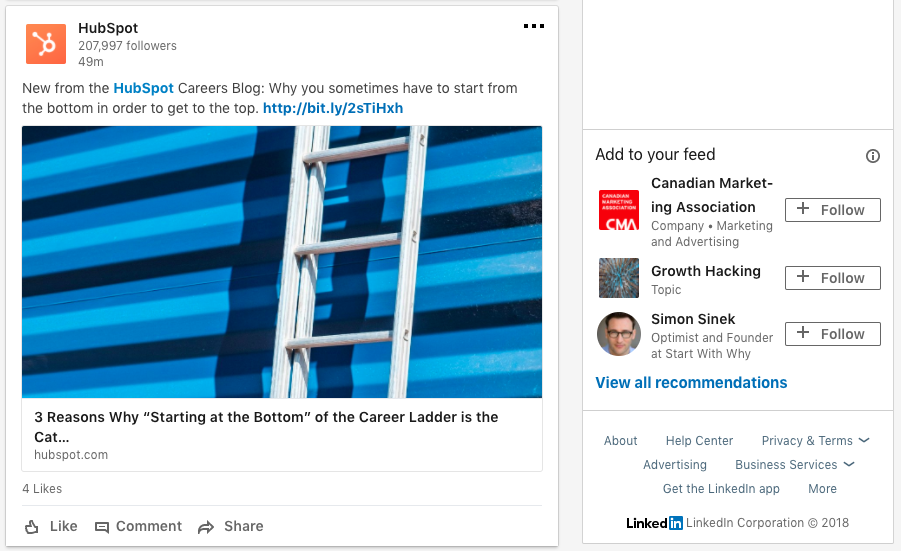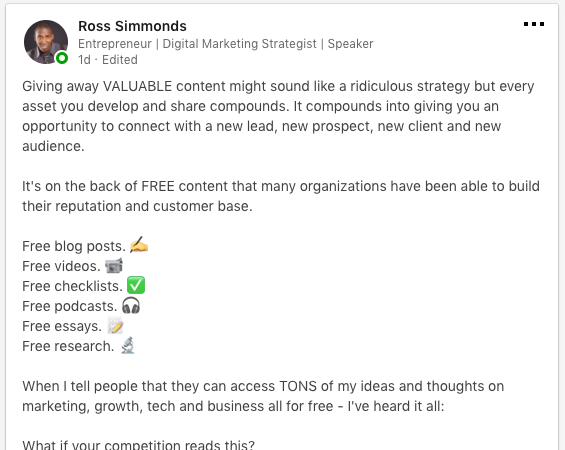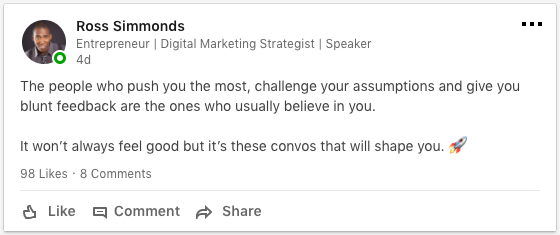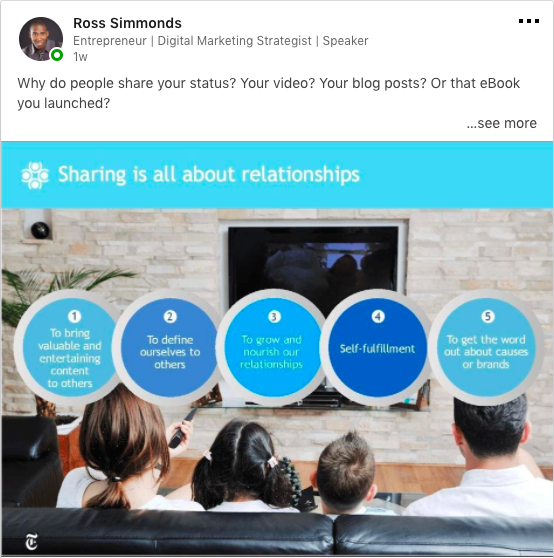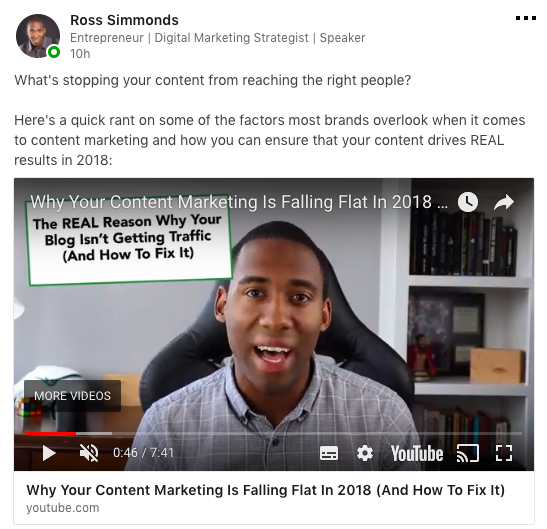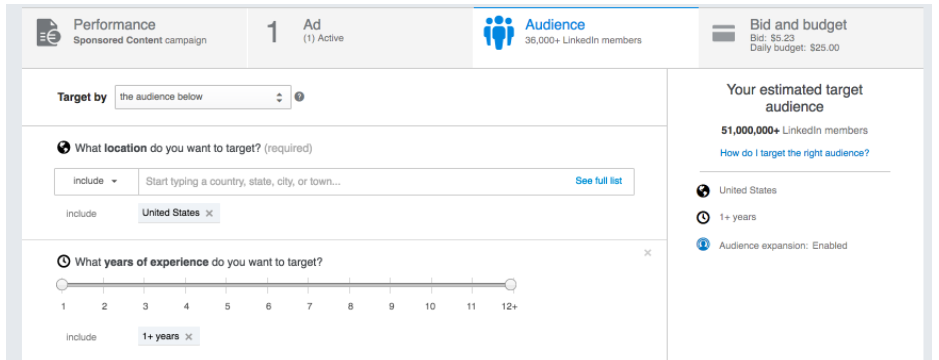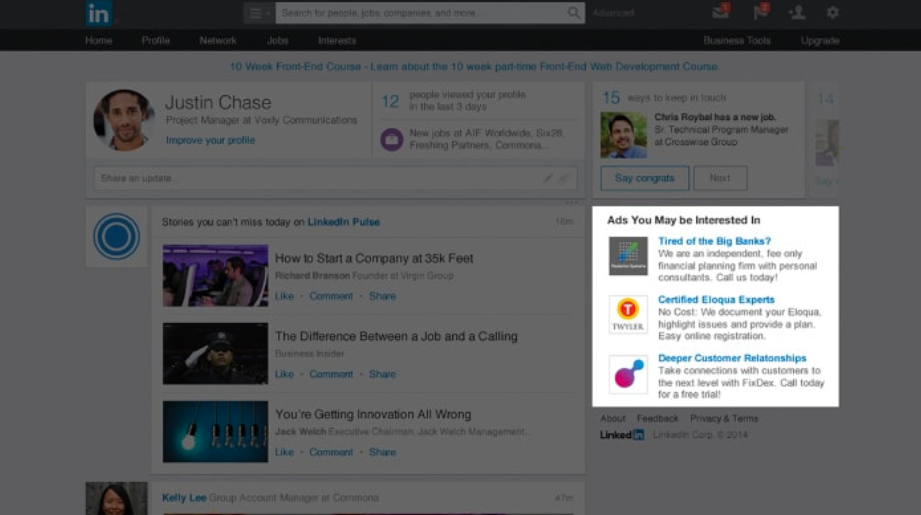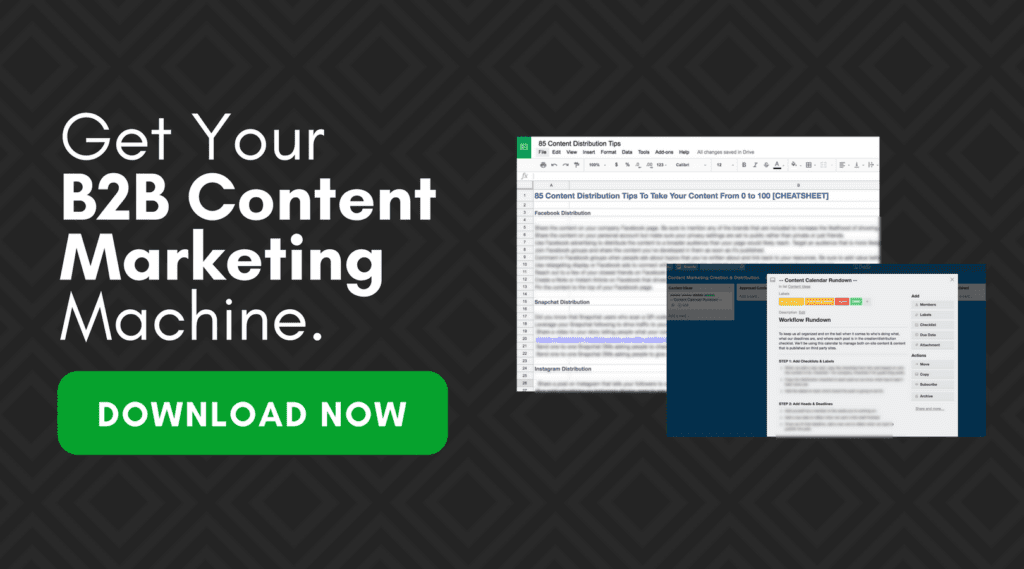 How To Market On LinkedIn In 2020:
How To Market On LinkedIn In 2020:
- Share Content From Your LinkedIn Business Page
- Leave Comments On Other LinkedIn Posts
- Write Long-Form LinkedIn Posts or Articles
- Distribute Content In LinkedIn Groups
- Set daily, weekly and monthly goals.
- Ask Colleagues To Share Your Posts
- Share Images With Links To Content
- Promote Assets With ‘Sponsored Content’
- Promote LinkedIn Content With Text Ads
- Use ‘Sponsored InMail’ For Your Content
If you’re in B2B, LinkedIn marketing and promotion as a channel for lead generation is on your mind.
No matter what niche you’re focused on, there’s always going to be a focus on bringing qualified leads through the door. After all, leads become customers, and customers become revenue.
So as a B2B marketer, where are you spending the bulk of your time?
When you’re thinking about content distribution, what channels are you going to first?
What tactics are you running with to bring in those leads?
Are you seeing the results you’re hoping for?
I’m going to let you in on the worst-kept secret in the B2B marketing world…
In B2B, LinkedIn Marketing & Promotion is KING.
Sure Facebook and Twitter have more users, and Instagram gets more love for being fun, but the bottom line is LinkedIn brings in results. If you’re looking for a few B2B-focused LinkedIn stats…
- It’s the #1 channel B2B marketers use to distribute content at 94%.
- 91% of marketing executives list LinkedIn as the top place to find quality content.
- LinkedIn makes up more than 50% of all social traffic to B2B websites & blogs.
As great as those stats are, the most important one is this:
80% of B2B leads come from LinkedIn vs. 13% on Twitter & 7% on Facebook.
If you’re focused on lead generation, those numbers alone should be all the convincing you need to jump on the LinkedIn Marketing bandwagon. Once you’ve bought into the WHY of LinkedIn, the next question is going to be HOW to do it right. And in this blog post, I’m going to break down every single marketing and promotion technique that you can use on LinkedIn. But before I do…
It’s important to understand the mistakes that FAR too many people make on LinkedIn.
Here’s a rundown on some of the most popular mistakes so you can avoid them:
Let’s dive in…
Organic Marketing Tactics For LinkedIn
Even if you have the resources to dive into the world of paid distribution on LinkedIn, ignoring the free organic distribution possibilities you can run with is unwise, to say the least. When you’re building out your LinkedIn marketing strategy, start with these tactics in mind:
1. Share From Your LinkedIn Business Page
This one might seem like a no-brainer, but it’s something I see far too many B2B brands dropping the ball on. When you’re thinking about content distribution on LinkedIn, make sure you have a company page set up, and use it to share your content.
When your content is showing up in a LinkedIn user’s feed, you want to make it as easy as possible for them to recognize your brand and connect it with the value you’re providing.
2. Leave Comments On Other LinkedIn Posts
I’m a huge proponent of dropping comments on as many posts as you can for two reasons:
When you comment on a post, you’re setting up a conversation between the author of the post and yourself. That conversation is key to building the relationship between the two of you, and the more you comment on and engage with their posts, the more likely they are to do the same on yours.
One on one relationship building aside, if you comment on someone’s post, your name will be right there for any and all of their connections to see when the post pops up. Something as simple as dropping a valuable comment on a value-packed post is all it takes to put your name in front of a brand new audience of people interested in your area of expertise.
3. Write Long-Form LinkedIn Posts or Articles
In order for your content to be as successful as you want it to be, the focus needs to be on providing value first and foremost. If you’re not providing any value, no one’s going to pay attention to whatever you’re sharing.
One of the best ways to jump into someone’s feed with value is to share long-form posts like this one and value-packed LinkedIn articles. Rather than just shipping a ton of quick 20 to 50 character updates, share something with some serious meat on the bones.
Don’t think just because you’re only sharing a standard post you can’t still get creative and bring some value to the table.
4. Distribute Content In LinkedIn Groups
LinkedIn groups are once again on the rise, according to LinkedIn themselves. With the success Facebook groups have seen recently, this news shouldn’t come as much of a surprise. Let’s break it down a bit…
LinkedIn groups are essentially a giant room filled with the exact people you want to target. If you’re trying to get in touch with B2B marketers, join some B2B marketing LinkedIn groups. Trying to reach SaaS founders? Join a SaaS-focused LinkedIn group.
Once you’re in, start jumping in with discussion posts that accomplish two things: (1) provide major value to those who see it, because value should always come first, and (2) drive traffic back to your content pieces. If you have a blog post about how to use emojis in B2B, groups can be the channel you need to get B2B marketers to land on that content.
5. Visit Your Audience’s LinkedIn Profiles
It may sound like a small move, but something as simple as viewing the profile of people you’re trying to reach can work wonders if you do it in tandem with something else.
Whenever you view someone’s profile, they’ll get a notification saying just that. They’ll see your face and name and know that you showed some interest in them. If they then see a post of yours in their feed or a direct message from you, they’ll already recognize you and it’ll be more likely to capture their attention.
Instead of just hoping those C-suite executives you’re trying to reach happen to see your content in their noise-filled feed, take a few extra steps to make it jump out at them as much as possible.
6. Share Text Based Status Updates
On most social networks, engagement typically rises when you attach an image or video to a post. The same can’t be said for LinkedIn. Here’s what a quick study from Social Media Examiner found in terms of views and engagement:
When you’re scrolling through your feed, how often do you see a post with a link or an image going viral with likes and comments? Maybe you’ve seen a few, but you’re much more likely to see text-only posts blowing up in the feed.
It may be an algorithm thing, or it may just be that text-only posts seem to fit more naturally in the feed and are easier to consume. Regardless, don’t run away from the text-only approach. They’re key to building trust with your connections and proving your credibility in your area of expertise.
7. Ask Colleagues To Share Your LinkedIn Posts
In the age of the algorithm, the more traction your post gets in its early stages, the more love it’s going to get from the algorithm, and the more reach it’s going to end up having.
Don’t shy away from the shameless like and share requests.
If you’re on a sales team of 10 people, don’t just hit publish and hope they come across it and give it a like. Shoot your team a link and ask if they could take a second to like it. Even if only 6 or 7 of them give you that like, you’re still 6 or 7 likes ahead of where you were before you asked.
Sure that doesn’t sound like the viral traction you’re looking for, but remember: whenever you share a new LinkedIn post, the more engagement you get, the more reach you’ll get.
8. Share Images With References To Content
At this point, we know that providing value in each and every one of your posts is key. With that in mind, experiment with sharing certain images from your content pieces that provide that little bit of value.
If you have an infographic in one of your blog posts, plug it into your LinkedIn post and send them to the full post if they’re looking for more. If you’ve done some primary research, share one of your graphs or tables to arm them with insights. When you’re thinking value-first, you’re setting yourself up for success.
In the post I shared below, the image provides anyone who sees it with some value on its own. If they want even more value, it’s as easy as following a link at the end of the post itself. They’re much more likely to trust its credibility if they’ve already gotten some value from me before even opening the full blog post.
9. Share Videos Driving People To Your Content
It’s 2018 and video is bigger than ever before. There are dozens of new video marketing trends that are changing the game. Over the past year, LinkedIn has started rolling out some native video sharing tools of their own. If this isn’t proof that they’re boosting video content in their user’s feeds, I don’t know what is.
Just like an image can provide value up front, a video can provide massive value to a reader before they even read a word.
Whether you’re sharing a full video like I do down below, or just a quick, minute-long preview snippet to drive people to a full-length video or blog post, attaching a video to your LinkedIn posts is going to help.
10. Follow Up With Personalized Notes
In the modern day, one-to-one marketing world, personalization is key. If you’re trying to reach a certain person or target persona on LinkedIn, sitting back and hoping they see your content isn’t going to be the best plan of attack.
Start trying to build a relationship with them.
When you’re sending connection requests, attach a personalized note. Don’t just blast out a blank request and expect them to accept it and recognize everything you’re sharing. Give them a reason to care about you and recognize you. You may even consider upgrading to premium, so you can leverage InMail messages.
11. Create A LinkedIn Engagement Group
When we’re talking LinkedIn algorithms, engagement is key no matter what. I know I mentioned it earlier, but the more engagement you can get on your posts, the more people those posts are going to reach.
So what can you do to drive that engagement up from the jump?
First thing’s first, ask for the shares from your team. We talked about it already, but this should be easy engagement to get. If you don’t have a team or you have a team that isn’t too keen on sharing each and every post, creating a dedicated engagement group is something to consider.
It could be as simple as a Slack channel dedicated to boosting engagement for everyone in the group. You just jump in with a link to your post, ask for some likes, and watch your engagement numbers climb.
Of course, it’s got to be a two-way street. You can’t jump in asking for likes if you’re not willing to return the favor when the other members share posts of their own.
Paid Marketing Tactics For LinkedIn
If you have the resources, paid distribution efforts are definitely worth experimenting with. LinkedIn’s Marketing Solutions Blog shared a post highlighting 10 examples of LinkedIn ad campaigns that brought in great results that’ll be a great resource for some extra inspiration once you start dabbling into the paid side of things. As you build out your LinkedIn strategy even further, keep these three key paid distribution options top of mind:
1. Promote Content With ‘Sponsored Content’
LinkedIn sponsored content lets you place your best-performing posts in front of a much wider audience of people likely to be interested in what you’re sharing.
Once you build a solid understanding of who your target audience actually is, sponsored content can be the perfect tool to get your brand in front of them. Just don’t forget to set up your company page the way you want it since the traffic is about to start rolling in.
2. Drive People To Content With ‘Sponsored InMail’
If you’re trying to drive specific people to the content you’re sharing, sponsored InMail is the way to go. You can target ideal prospects directly and send them to content you’ve created that’s optimized to convert prospects into hot leads.
With the B2B marketing scene shifting from the one-to-many to one-to-one, personalization is key to converting leads. Instead of just hoping your list of highly qualified leads sees the content you share, jump into their DMs and make it easy for them.
3. Promote LinkedIn Content With Text Ads
While sponsored content appears in the feed as a native LinkedIn post that can be liked, shared, and commented on, LinkedIn Text Ads are more like standalone “suggested for you” ads that appear in the sidebar and at the end of a LinkedIn article.
The benefit here is a Text Ad on LinkedIn is easy to create and gives you massive targeting options. Everything down to a user’s job title, age, alma mater… Before long you might even be able to target based on shoe size.
LinkedIn’s Marketing Solutions Blog has plenty of suggestions on ad optimization best practices that are worth checking out before you dive in.
Wrapping Things Up
There you have it.
That’s 14 content distribution tactics to keep in mind as you build out your LinkedIn marketing strategy. I’ve used every single one of them at one point or another to build influence, generate leads, and drive results from LinkedIn.
Here’s a quick recap of all 14 tactics you can start running with today:
Organic:
- Share From Your Business Page
- Leave Comments On Posts
- Write Long-Form Posts or Articles
- Distribute Content In LinkedIn Groups
- Visit Your Audience’s Profiles
- Share Text Oriented Status Updates
- Ask Colleagues To Help Share
- Share Images With Reference To Content
- Share Videos Driving To Your Content
- Follow Up With Personalized Notes
- Create An Engagement Group
Paid:
- Promote Content With ‘Sponsored Content’
- Drive People To Content With ‘Sponsored InMail’
- Promote Content With Text Ads
As you start to implement whichever tactics fit your needs best, always keep in mind the idea that value must come first if you want to see real results.
Give them a reason to care about what you’re sharing, and make sure they’re walking away from every interaction with something they can use. Building that trust and credibility will only increase the results you see from your distribution efforts.
If you’re really looking to dive into the content distribution game, I’ve put together a 100% free resource with over 85 of my best distribution tips. Just download your copy for free today and start driving more results from your content distribution efforts.

